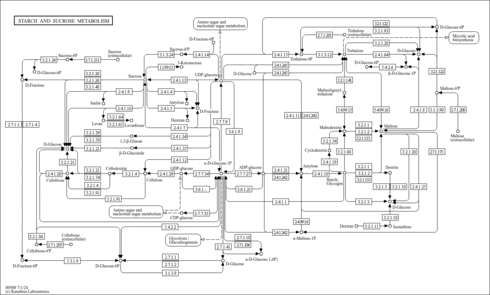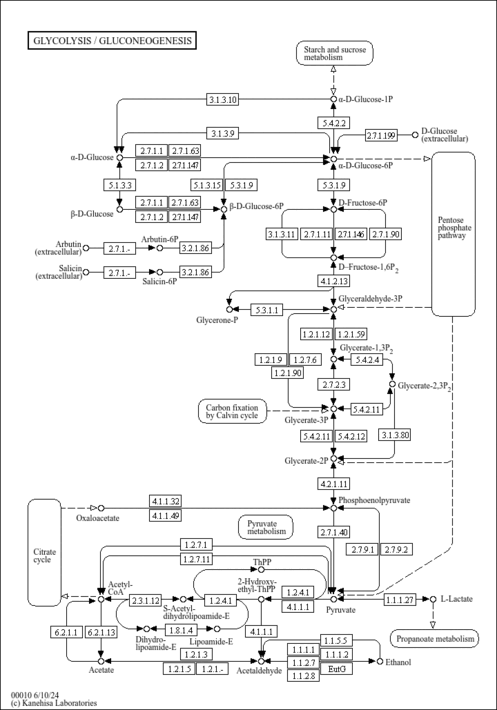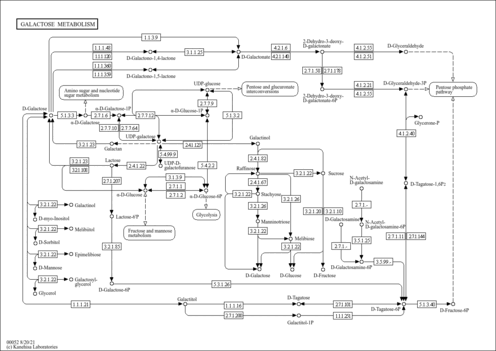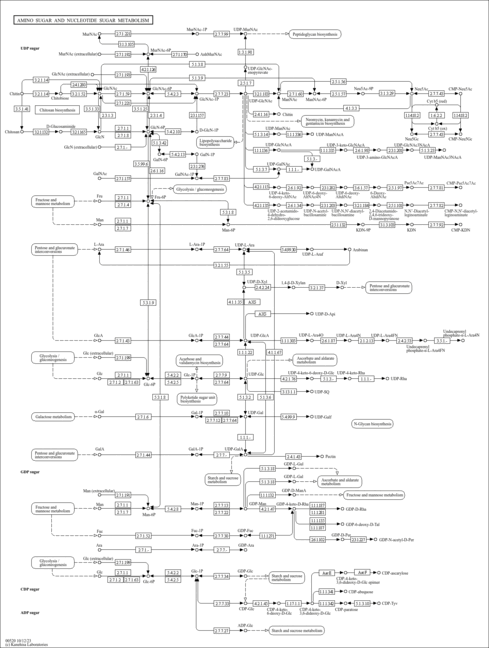| Glucose 1-phosphate,1TMS,isomer #1 | C[Si](C)(C)OC[C@H]1O[C@H](OP(=O)(O)O)[C@H](O)[C@@H](O)[C@@H]1O | 2170.1 | Semi standard non polar | 33892256 |
| Glucose 1-phosphate,1TMS,isomer #2 | C[Si](C)(C)O[C@@H]1[C@@H](O)[C@H](O)[C@@H](CO)O[C@@H]1OP(=O)(O)O | 2110.0 | Semi standard non polar | 33892256 |
| Glucose 1-phosphate,1TMS,isomer #3 | C[Si](C)(C)O[C@H]1[C@H](O)[C@@H](CO)O[C@H](OP(=O)(O)O)[C@@H]1O | 2104.3 | Semi standard non polar | 33892256 |
| Glucose 1-phosphate,1TMS,isomer #4 | C[Si](C)(C)O[C@@H]1[C@@H](CO)O[C@H](OP(=O)(O)O)[C@H](O)[C@H]1O | 2113.5 | Semi standard non polar | 33892256 |
| Glucose 1-phosphate,1TMS,isomer #5 | C[Si](C)(C)OP(=O)(O)O[C@H]1O[C@H](CO)[C@@H](O)[C@H](O)[C@H]1O | 2173.1 | Semi standard non polar | 33892256 |
| Glucose 1-phosphate,2TMS,isomer #1 | C[Si](C)(C)OC[C@H]1O[C@H](OP(=O)(O)O)[C@H](O[Si](C)(C)C)[C@@H](O)[C@@H]1O | 2119.8 | Semi standard non polar | 33892256 |
| Glucose 1-phosphate,2TMS,isomer #10 | C[Si](C)(C)O[C@@H]1[C@@H](CO)O[C@H](OP(=O)(O)O[Si](C)(C)C)[C@H](O)[C@H]1O | 2153.0 | Semi standard non polar | 33892256 |
| Glucose 1-phosphate,2TMS,isomer #11 | C[Si](C)(C)OP(=O)(O[C@H]1O[C@H](CO)[C@@H](O)[C@H](O)[C@H]1O)O[Si](C)(C)C | 2194.1 | Semi standard non polar | 33892256 |
| Glucose 1-phosphate,2TMS,isomer #2 | C[Si](C)(C)OC[C@H]1O[C@H](OP(=O)(O)O)[C@H](O)[C@@H](O[Si](C)(C)C)[C@@H]1O | 2122.7 | Semi standard non polar | 33892256 |
| Glucose 1-phosphate,2TMS,isomer #3 | C[Si](C)(C)OC[C@H]1O[C@H](OP(=O)(O)O)[C@H](O)[C@@H](O)[C@@H]1O[Si](C)(C)C | 2132.5 | Semi standard non polar | 33892256 |
| Glucose 1-phosphate,2TMS,isomer #4 | C[Si](C)(C)OC[C@H]1O[C@H](OP(=O)(O)O[Si](C)(C)C)[C@H](O)[C@@H](O)[C@@H]1O | 2188.9 | Semi standard non polar | 33892256 |
| Glucose 1-phosphate,2TMS,isomer #5 | C[Si](C)(C)O[C@H]1[C@H](O)[C@@H](CO)O[C@H](OP(=O)(O)O)[C@@H]1O[Si](C)(C)C | 2110.0 | Semi standard non polar | 33892256 |
| Glucose 1-phosphate,2TMS,isomer #6 | C[Si](C)(C)O[C@H]1[C@H](O)[C@@H](O[Si](C)(C)C)[C@@H](OP(=O)(O)O)O[C@@H]1CO | 2086.1 | Semi standard non polar | 33892256 |
| Glucose 1-phosphate,2TMS,isomer #7 | C[Si](C)(C)O[C@@H]1[C@@H](O)[C@H](O)[C@@H](CO)O[C@@H]1OP(=O)(O)O[Si](C)(C)C | 2162.5 | Semi standard non polar | 33892256 |
| Glucose 1-phosphate,2TMS,isomer #8 | C[Si](C)(C)O[C@@H]1[C@@H](CO)O[C@H](OP(=O)(O)O)[C@H](O)[C@H]1O[Si](C)(C)C | 2096.0 | Semi standard non polar | 33892256 |
| Glucose 1-phosphate,2TMS,isomer #9 | C[Si](C)(C)O[C@H]1[C@H](O)[C@@H](CO)O[C@H](OP(=O)(O)O[Si](C)(C)C)[C@@H]1O | 2160.7 | Semi standard non polar | 33892256 |
| Glucose 1-phosphate,3TMS,isomer #1 | C[Si](C)(C)OC[C@H]1O[C@H](OP(=O)(O)O)[C@H](O[Si](C)(C)C)[C@@H](O[Si](C)(C)C)[C@@H]1O | 2124.2 | Semi standard non polar | 33892256 |
| Glucose 1-phosphate,3TMS,isomer #10 | C[Si](C)(C)O[C@H]1[C@H](O)[C@@H](O[Si](C)(C)C)[C@@H](OP(=O)(O)O[Si](C)(C)C)O[C@@H]1CO | 2120.4 | Semi standard non polar | 33892256 |
| Glucose 1-phosphate,3TMS,isomer #11 | C[Si](C)(C)O[C@@H]1[C@@H](O)[C@H](O)[C@@H](CO)O[C@@H]1OP(=O)(O[Si](C)(C)C)O[Si](C)(C)C | 2116.3 | Semi standard non polar | 33892256 |
| Glucose 1-phosphate,3TMS,isomer #12 | C[Si](C)(C)O[C@@H]1[C@@H](CO)O[C@H](OP(=O)(O)O[Si](C)(C)C)[C@H](O)[C@H]1O[Si](C)(C)C | 2119.5 | Semi standard non polar | 33892256 |
| Glucose 1-phosphate,3TMS,isomer #13 | C[Si](C)(C)O[C@H]1[C@H](O)[C@@H](CO)O[C@H](OP(=O)(O[Si](C)(C)C)O[Si](C)(C)C)[C@@H]1O | 2124.3 | Semi standard non polar | 33892256 |
| Glucose 1-phosphate,3TMS,isomer #14 | C[Si](C)(C)O[C@@H]1[C@@H](CO)O[C@H](OP(=O)(O[Si](C)(C)C)O[Si](C)(C)C)[C@H](O)[C@H]1O | 2105.0 | Semi standard non polar | 33892256 |
| Glucose 1-phosphate,3TMS,isomer #2 | C[Si](C)(C)OC[C@H]1O[C@H](OP(=O)(O)O)[C@H](O[Si](C)(C)C)[C@@H](O)[C@@H]1O[Si](C)(C)C | 2123.3 | Semi standard non polar | 33892256 |
| Glucose 1-phosphate,3TMS,isomer #3 | C[Si](C)(C)OC[C@H]1O[C@H](OP(=O)(O)O[Si](C)(C)C)[C@H](O[Si](C)(C)C)[C@@H](O)[C@@H]1O | 2104.2 | Semi standard non polar | 33892256 |
| Glucose 1-phosphate,3TMS,isomer #4 | C[Si](C)(C)OC[C@H]1O[C@H](OP(=O)(O)O)[C@H](O)[C@@H](O[Si](C)(C)C)[C@@H]1O[Si](C)(C)C | 2118.8 | Semi standard non polar | 33892256 |
| Glucose 1-phosphate,3TMS,isomer #5 | C[Si](C)(C)OC[C@H]1O[C@H](OP(=O)(O)O[Si](C)(C)C)[C@H](O)[C@@H](O[Si](C)(C)C)[C@@H]1O | 2119.4 | Semi standard non polar | 33892256 |
| Glucose 1-phosphate,3TMS,isomer #6 | C[Si](C)(C)OC[C@H]1O[C@H](OP(=O)(O)O[Si](C)(C)C)[C@H](O)[C@@H](O)[C@@H]1O[Si](C)(C)C | 2103.6 | Semi standard non polar | 33892256 |
| Glucose 1-phosphate,3TMS,isomer #7 | C[Si](C)(C)OC[C@H]1O[C@H](OP(=O)(O[Si](C)(C)C)O[Si](C)(C)C)[C@H](O)[C@@H](O)[C@@H]1O | 2126.0 | Semi standard non polar | 33892256 |
| Glucose 1-phosphate,3TMS,isomer #8 | C[Si](C)(C)O[C@H]1[C@H](O[Si](C)(C)C)[C@@H](CO)O[C@H](OP(=O)(O)O)[C@@H]1O[Si](C)(C)C | 2126.4 | Semi standard non polar | 33892256 |
| Glucose 1-phosphate,3TMS,isomer #9 | C[Si](C)(C)O[C@H]1[C@H](O)[C@@H](CO)O[C@H](OP(=O)(O)O[Si](C)(C)C)[C@@H]1O[Si](C)(C)C | 2119.6 | Semi standard non polar | 33892256 |
| Glucose 1-phosphate,4TMS,isomer #1 | C[Si](C)(C)OC[C@H]1O[C@H](OP(=O)(O)O)[C@H](O[Si](C)(C)C)[C@@H](O[Si](C)(C)C)[C@@H]1O[Si](C)(C)C | 2139.3 | Semi standard non polar | 33892256 |
| Glucose 1-phosphate,4TMS,isomer #10 | C[Si](C)(C)O[C@H]1[C@H](O)[C@@H](O[Si](C)(C)C)[C@@H](OP(=O)(O[Si](C)(C)C)O[Si](C)(C)C)O[C@@H]1CO | 2186.2 | Semi standard non polar | 33892256 |
| Glucose 1-phosphate,4TMS,isomer #11 | C[Si](C)(C)O[C@@H]1[C@@H](CO)O[C@H](OP(=O)(O[Si](C)(C)C)O[Si](C)(C)C)[C@H](O)[C@H]1O[Si](C)(C)C | 2185.6 | Semi standard non polar | 33892256 |
| Glucose 1-phosphate,4TMS,isomer #2 | C[Si](C)(C)OC[C@H]1O[C@H](OP(=O)(O)O[Si](C)(C)C)[C@H](O[Si](C)(C)C)[C@@H](O[Si](C)(C)C)[C@@H]1O | 2159.3 | Semi standard non polar | 33892256 |
| Glucose 1-phosphate,4TMS,isomer #3 | C[Si](C)(C)OC[C@H]1O[C@H](OP(=O)(O)O[Si](C)(C)C)[C@H](O[Si](C)(C)C)[C@@H](O)[C@@H]1O[Si](C)(C)C | 2162.1 | Semi standard non polar | 33892256 |
| Glucose 1-phosphate,4TMS,isomer #4 | C[Si](C)(C)OC[C@H]1O[C@H](OP(=O)(O[Si](C)(C)C)O[Si](C)(C)C)[C@H](O[Si](C)(C)C)[C@@H](O)[C@@H]1O | 2128.2 | Semi standard non polar | 33892256 |
| Glucose 1-phosphate,4TMS,isomer #5 | C[Si](C)(C)OC[C@H]1O[C@H](OP(=O)(O)O[Si](C)(C)C)[C@H](O)[C@@H](O[Si](C)(C)C)[C@@H]1O[Si](C)(C)C | 2155.0 | Semi standard non polar | 33892256 |
| Glucose 1-phosphate,4TMS,isomer #6 | C[Si](C)(C)OC[C@H]1O[C@H](OP(=O)(O[Si](C)(C)C)O[Si](C)(C)C)[C@H](O)[C@@H](O[Si](C)(C)C)[C@@H]1O | 2171.7 | Semi standard non polar | 33892256 |
| Glucose 1-phosphate,4TMS,isomer #7 | C[Si](C)(C)OC[C@H]1O[C@H](OP(=O)(O[Si](C)(C)C)O[Si](C)(C)C)[C@H](O)[C@@H](O)[C@@H]1O[Si](C)(C)C | 2127.0 | Semi standard non polar | 33892256 |
| Glucose 1-phosphate,4TMS,isomer #8 | C[Si](C)(C)O[C@H]1[C@H](O[Si](C)(C)C)[C@@H](CO)O[C@H](OP(=O)(O)O[Si](C)(C)C)[C@@H]1O[Si](C)(C)C | 2169.6 | Semi standard non polar | 33892256 |
| Glucose 1-phosphate,4TMS,isomer #9 | C[Si](C)(C)O[C@H]1[C@H](O)[C@@H](CO)O[C@H](OP(=O)(O[Si](C)(C)C)O[Si](C)(C)C)[C@@H]1O[Si](C)(C)C | 2190.0 | Semi standard non polar | 33892256 |
| Glucose 1-phosphate,5TMS,isomer #1 | C[Si](C)(C)OC[C@H]1O[C@H](OP(=O)(O)O[Si](C)(C)C)[C@H](O[Si](C)(C)C)[C@@H](O[Si](C)(C)C)[C@@H]1O[Si](C)(C)C | 2170.2 | Semi standard non polar | 33892256 |
| Glucose 1-phosphate,5TMS,isomer #1 | C[Si](C)(C)OC[C@H]1O[C@H](OP(=O)(O)O[Si](C)(C)C)[C@H](O[Si](C)(C)C)[C@@H](O[Si](C)(C)C)[C@@H]1O[Si](C)(C)C | 2203.3 | Standard non polar | 33892256 |
| Glucose 1-phosphate,5TMS,isomer #1 | C[Si](C)(C)OC[C@H]1O[C@H](OP(=O)(O)O[Si](C)(C)C)[C@H](O[Si](C)(C)C)[C@@H](O[Si](C)(C)C)[C@@H]1O[Si](C)(C)C | 2588.2 | Standard polar | 33892256 |
| Glucose 1-phosphate,5TMS,isomer #2 | C[Si](C)(C)OC[C@H]1O[C@H](OP(=O)(O[Si](C)(C)C)O[Si](C)(C)C)[C@H](O[Si](C)(C)C)[C@@H](O[Si](C)(C)C)[C@@H]1O | 2183.8 | Semi standard non polar | 33892256 |
| Glucose 1-phosphate,5TMS,isomer #2 | C[Si](C)(C)OC[C@H]1O[C@H](OP(=O)(O[Si](C)(C)C)O[Si](C)(C)C)[C@H](O[Si](C)(C)C)[C@@H](O[Si](C)(C)C)[C@@H]1O | 2240.0 | Standard non polar | 33892256 |
| Glucose 1-phosphate,5TMS,isomer #2 | C[Si](C)(C)OC[C@H]1O[C@H](OP(=O)(O[Si](C)(C)C)O[Si](C)(C)C)[C@H](O[Si](C)(C)C)[C@@H](O[Si](C)(C)C)[C@@H]1O | 2518.6 | Standard polar | 33892256 |
| Glucose 1-phosphate,5TMS,isomer #3 | C[Si](C)(C)OC[C@H]1O[C@H](OP(=O)(O[Si](C)(C)C)O[Si](C)(C)C)[C@H](O[Si](C)(C)C)[C@@H](O)[C@@H]1O[Si](C)(C)C | 2180.4 | Semi standard non polar | 33892256 |
| Glucose 1-phosphate,5TMS,isomer #3 | C[Si](C)(C)OC[C@H]1O[C@H](OP(=O)(O[Si](C)(C)C)O[Si](C)(C)C)[C@H](O[Si](C)(C)C)[C@@H](O)[C@@H]1O[Si](C)(C)C | 2251.0 | Standard non polar | 33892256 |
| Glucose 1-phosphate,5TMS,isomer #3 | C[Si](C)(C)OC[C@H]1O[C@H](OP(=O)(O[Si](C)(C)C)O[Si](C)(C)C)[C@H](O[Si](C)(C)C)[C@@H](O)[C@@H]1O[Si](C)(C)C | 2484.5 | Standard polar | 33892256 |
| Glucose 1-phosphate,5TMS,isomer #4 | C[Si](C)(C)OC[C@H]1O[C@H](OP(=O)(O[Si](C)(C)C)O[Si](C)(C)C)[C@H](O)[C@@H](O[Si](C)(C)C)[C@@H]1O[Si](C)(C)C | 2178.4 | Semi standard non polar | 33892256 |
| Glucose 1-phosphate,5TMS,isomer #4 | C[Si](C)(C)OC[C@H]1O[C@H](OP(=O)(O[Si](C)(C)C)O[Si](C)(C)C)[C@H](O)[C@@H](O[Si](C)(C)C)[C@@H]1O[Si](C)(C)C | 2242.0 | Standard non polar | 33892256 |
| Glucose 1-phosphate,5TMS,isomer #4 | C[Si](C)(C)OC[C@H]1O[C@H](OP(=O)(O[Si](C)(C)C)O[Si](C)(C)C)[C@H](O)[C@@H](O[Si](C)(C)C)[C@@H]1O[Si](C)(C)C | 2494.6 | Standard polar | 33892256 |
| Glucose 1-phosphate,5TMS,isomer #5 | C[Si](C)(C)O[C@H]1[C@H](O[Si](C)(C)C)[C@@H](CO)O[C@H](OP(=O)(O[Si](C)(C)C)O[Si](C)(C)C)[C@@H]1O[Si](C)(C)C | 2194.1 | Semi standard non polar | 33892256 |
| Glucose 1-phosphate,5TMS,isomer #5 | C[Si](C)(C)O[C@H]1[C@H](O[Si](C)(C)C)[C@@H](CO)O[C@H](OP(=O)(O[Si](C)(C)C)O[Si](C)(C)C)[C@@H]1O[Si](C)(C)C | 2213.5 | Standard non polar | 33892256 |
| Glucose 1-phosphate,5TMS,isomer #5 | C[Si](C)(C)O[C@H]1[C@H](O[Si](C)(C)C)[C@@H](CO)O[C@H](OP(=O)(O[Si](C)(C)C)O[Si](C)(C)C)[C@@H]1O[Si](C)(C)C | 2475.5 | Standard polar | 33892256 |
| Glucose 1-phosphate,6TMS,isomer #1 | C[Si](C)(C)OC[C@H]1O[C@H](OP(=O)(O[Si](C)(C)C)O[Si](C)(C)C)[C@H](O[Si](C)(C)C)[C@@H](O[Si](C)(C)C)[C@@H]1O[Si](C)(C)C | 2220.2 | Semi standard non polar | 33892256 |
| Glucose 1-phosphate,6TMS,isomer #1 | C[Si](C)(C)OC[C@H]1O[C@H](OP(=O)(O[Si](C)(C)C)O[Si](C)(C)C)[C@H](O[Si](C)(C)C)[C@@H](O[Si](C)(C)C)[C@@H]1O[Si](C)(C)C | 2279.1 | Standard non polar | 33892256 |
| Glucose 1-phosphate,6TMS,isomer #1 | C[Si](C)(C)OC[C@H]1O[C@H](OP(=O)(O[Si](C)(C)C)O[Si](C)(C)C)[C@H](O[Si](C)(C)C)[C@@H](O[Si](C)(C)C)[C@@H]1O[Si](C)(C)C | 2440.7 | Standard polar | 33892256 |
| Glucose 1-phosphate,1TBDMS,isomer #1 | CC(C)(C)[Si](C)(C)OC[C@H]1O[C@H](OP(=O)(O)O)[C@H](O)[C@@H](O)[C@@H]1O | 2416.7 | Semi standard non polar | 33892256 |
| Glucose 1-phosphate,1TBDMS,isomer #2 | CC(C)(C)[Si](C)(C)O[C@@H]1[C@@H](O)[C@H](O)[C@@H](CO)O[C@@H]1OP(=O)(O)O | 2388.0 | Semi standard non polar | 33892256 |
| Glucose 1-phosphate,1TBDMS,isomer #3 | CC(C)(C)[Si](C)(C)O[C@H]1[C@H](O)[C@@H](CO)O[C@H](OP(=O)(O)O)[C@@H]1O | 2386.8 | Semi standard non polar | 33892256 |
| Glucose 1-phosphate,1TBDMS,isomer #4 | CC(C)(C)[Si](C)(C)O[C@@H]1[C@@H](CO)O[C@H](OP(=O)(O)O)[C@H](O)[C@H]1O | 2388.0 | Semi standard non polar | 33892256 |
| Glucose 1-phosphate,1TBDMS,isomer #5 | CC(C)(C)[Si](C)(C)OP(=O)(O)O[C@H]1O[C@H](CO)[C@@H](O)[C@H](O)[C@H]1O | 2422.3 | Semi standard non polar | 33892256 |
| Glucose 1-phosphate,2TBDMS,isomer #1 | CC(C)(C)[Si](C)(C)OC[C@H]1O[C@H](OP(=O)(O)O)[C@H](O[Si](C)(C)C(C)(C)C)[C@@H](O)[C@@H]1O | 2562.8 | Semi standard non polar | 33892256 |
| Glucose 1-phosphate,2TBDMS,isomer #10 | CC(C)(C)[Si](C)(C)O[C@@H]1[C@@H](CO)O[C@H](OP(=O)(O)O[Si](C)(C)C(C)(C)C)[C@H](O)[C@H]1O | 2606.1 | Semi standard non polar | 33892256 |
| Glucose 1-phosphate,2TBDMS,isomer #11 | CC(C)(C)[Si](C)(C)OP(=O)(O[C@H]1O[C@H](CO)[C@@H](O)[C@H](O)[C@H]1O)O[Si](C)(C)C(C)(C)C | 2629.9 | Semi standard non polar | 33892256 |
| Glucose 1-phosphate,2TBDMS,isomer #2 | CC(C)(C)[Si](C)(C)OC[C@H]1O[C@H](OP(=O)(O)O)[C@H](O)[C@@H](O[Si](C)(C)C(C)(C)C)[C@@H]1O | 2576.9 | Semi standard non polar | 33892256 |
| Glucose 1-phosphate,2TBDMS,isomer #3 | CC(C)(C)[Si](C)(C)OC[C@H]1O[C@H](OP(=O)(O)O)[C@H](O)[C@@H](O)[C@@H]1O[Si](C)(C)C(C)(C)C | 2571.1 | Semi standard non polar | 33892256 |
| Glucose 1-phosphate,2TBDMS,isomer #4 | CC(C)(C)[Si](C)(C)OC[C@H]1O[C@H](OP(=O)(O)O[Si](C)(C)C(C)(C)C)[C@H](O)[C@@H](O)[C@@H]1O | 2631.0 | Semi standard non polar | 33892256 |
| Glucose 1-phosphate,2TBDMS,isomer #5 | CC(C)(C)[Si](C)(C)O[C@H]1[C@H](O)[C@@H](CO)O[C@H](OP(=O)(O)O)[C@@H]1O[Si](C)(C)C(C)(C)C | 2561.8 | Semi standard non polar | 33892256 |
| Glucose 1-phosphate,2TBDMS,isomer #6 | CC(C)(C)[Si](C)(C)O[C@H]1[C@H](O)[C@@H](O[Si](C)(C)C(C)(C)C)[C@@H](OP(=O)(O)O)O[C@@H]1CO | 2549.3 | Semi standard non polar | 33892256 |
| Glucose 1-phosphate,2TBDMS,isomer #7 | CC(C)(C)[Si](C)(C)O[C@@H]1[C@@H](O)[C@H](O)[C@@H](CO)O[C@@H]1OP(=O)(O)O[Si](C)(C)C(C)(C)C | 2612.5 | Semi standard non polar | 33892256 |
| Glucose 1-phosphate,2TBDMS,isomer #8 | CC(C)(C)[Si](C)(C)O[C@@H]1[C@@H](CO)O[C@H](OP(=O)(O)O)[C@H](O)[C@H]1O[Si](C)(C)C(C)(C)C | 2552.5 | Semi standard non polar | 33892256 |
| Glucose 1-phosphate,2TBDMS,isomer #9 | CC(C)(C)[Si](C)(C)O[C@H]1[C@H](O)[C@@H](CO)O[C@H](OP(=O)(O)O[Si](C)(C)C(C)(C)C)[C@@H]1O | 2606.6 | Semi standard non polar | 33892256 |
| Glucose 1-phosphate,3TBDMS,isomer #1 | CC(C)(C)[Si](C)(C)OC[C@H]1O[C@H](OP(=O)(O)O)[C@H](O[Si](C)(C)C(C)(C)C)[C@@H](O[Si](C)(C)C(C)(C)C)[C@@H]1O | 2757.5 | Semi standard non polar | 33892256 |
| Glucose 1-phosphate,3TBDMS,isomer #10 | CC(C)(C)[Si](C)(C)O[C@H]1[C@H](O)[C@@H](O[Si](C)(C)C(C)(C)C)[C@@H](OP(=O)(O)O[Si](C)(C)C(C)(C)C)O[C@@H]1CO | 2762.7 | Semi standard non polar | 33892256 |
| Glucose 1-phosphate,3TBDMS,isomer #11 | CC(C)(C)[Si](C)(C)O[C@@H]1[C@@H](O)[C@H](O)[C@@H](CO)O[C@@H]1OP(=O)(O[Si](C)(C)C(C)(C)C)O[Si](C)(C)C(C)(C)C | 2777.2 | Semi standard non polar | 33892256 |
| Glucose 1-phosphate,3TBDMS,isomer #12 | CC(C)(C)[Si](C)(C)O[C@@H]1[C@@H](CO)O[C@H](OP(=O)(O)O[Si](C)(C)C(C)(C)C)[C@H](O)[C@H]1O[Si](C)(C)C(C)(C)C | 2754.8 | Semi standard non polar | 33892256 |
| Glucose 1-phosphate,3TBDMS,isomer #13 | CC(C)(C)[Si](C)(C)O[C@H]1[C@H](O)[C@@H](CO)O[C@H](OP(=O)(O[Si](C)(C)C(C)(C)C)O[Si](C)(C)C(C)(C)C)[C@@H]1O | 2776.1 | Semi standard non polar | 33892256 |
| Glucose 1-phosphate,3TBDMS,isomer #14 | CC(C)(C)[Si](C)(C)O[C@@H]1[C@@H](CO)O[C@H](OP(=O)(O[Si](C)(C)C(C)(C)C)O[Si](C)(C)C(C)(C)C)[C@H](O)[C@H]1O | 2764.1 | Semi standard non polar | 33892256 |
| Glucose 1-phosphate,3TBDMS,isomer #2 | CC(C)(C)[Si](C)(C)OC[C@H]1O[C@H](OP(=O)(O)O)[C@H](O[Si](C)(C)C(C)(C)C)[C@@H](O)[C@@H]1O[Si](C)(C)C(C)(C)C | 2759.8 | Semi standard non polar | 33892256 |
| Glucose 1-phosphate,3TBDMS,isomer #3 | CC(C)(C)[Si](C)(C)OC[C@H]1O[C@H](OP(=O)(O)O[Si](C)(C)C(C)(C)C)[C@H](O[Si](C)(C)C(C)(C)C)[C@@H](O)[C@@H]1O | 2785.7 | Semi standard non polar | 33892256 |
| Glucose 1-phosphate,3TBDMS,isomer #4 | CC(C)(C)[Si](C)(C)OC[C@H]1O[C@H](OP(=O)(O)O)[C@H](O)[C@@H](O[Si](C)(C)C(C)(C)C)[C@@H]1O[Si](C)(C)C(C)(C)C | 2741.7 | Semi standard non polar | 33892256 |
| Glucose 1-phosphate,3TBDMS,isomer #5 | CC(C)(C)[Si](C)(C)OC[C@H]1O[C@H](OP(=O)(O)O[Si](C)(C)C(C)(C)C)[C@H](O)[C@@H](O[Si](C)(C)C(C)(C)C)[C@@H]1O | 2784.7 | Semi standard non polar | 33892256 |
| Glucose 1-phosphate,3TBDMS,isomer #6 | CC(C)(C)[Si](C)(C)OC[C@H]1O[C@H](OP(=O)(O)O[Si](C)(C)C(C)(C)C)[C@H](O)[C@@H](O)[C@@H]1O[Si](C)(C)C(C)(C)C | 2775.7 | Semi standard non polar | 33892256 |
| Glucose 1-phosphate,3TBDMS,isomer #7 | CC(C)(C)[Si](C)(C)OC[C@H]1O[C@H](OP(=O)(O[Si](C)(C)C(C)(C)C)O[Si](C)(C)C(C)(C)C)[C@H](O)[C@@H](O)[C@@H]1O | 2788.5 | Semi standard non polar | 33892256 |
| Glucose 1-phosphate,3TBDMS,isomer #8 | CC(C)(C)[Si](C)(C)O[C@H]1[C@H](O[Si](C)(C)C(C)(C)C)[C@@H](CO)O[C@H](OP(=O)(O)O)[C@@H]1O[Si](C)(C)C(C)(C)C | 2745.2 | Semi standard non polar | 33892256 |
| Glucose 1-phosphate,3TBDMS,isomer #9 | CC(C)(C)[Si](C)(C)O[C@H]1[C@H](O)[C@@H](CO)O[C@H](OP(=O)(O)O[Si](C)(C)C(C)(C)C)[C@@H]1O[Si](C)(C)C(C)(C)C | 2767.1 | Semi standard non polar | 33892256 |
| Glucose 1-phosphate,4TBDMS,isomer #1 | CC(C)(C)[Si](C)(C)OC[C@H]1O[C@H](OP(=O)(O)O)[C@H](O[Si](C)(C)C(C)(C)C)[C@@H](O[Si](C)(C)C(C)(C)C)[C@@H]1O[Si](C)(C)C(C)(C)C | 2970.8 | Semi standard non polar | 33892256 |
| Glucose 1-phosphate,4TBDMS,isomer #10 | CC(C)(C)[Si](C)(C)O[C@H]1[C@H](O)[C@@H](O[Si](C)(C)C(C)(C)C)[C@@H](OP(=O)(O[Si](C)(C)C(C)(C)C)O[Si](C)(C)C(C)(C)C)O[C@@H]1CO | 2977.4 | Semi standard non polar | 33892256 |
| Glucose 1-phosphate,4TBDMS,isomer #11 | CC(C)(C)[Si](C)(C)O[C@@H]1[C@@H](CO)O[C@H](OP(=O)(O[Si](C)(C)C(C)(C)C)O[Si](C)(C)C(C)(C)C)[C@H](O)[C@H]1O[Si](C)(C)C(C)(C)C | 2971.3 | Semi standard non polar | 33892256 |
| Glucose 1-phosphate,4TBDMS,isomer #2 | CC(C)(C)[Si](C)(C)OC[C@H]1O[C@H](OP(=O)(O)O[Si](C)(C)C(C)(C)C)[C@H](O[Si](C)(C)C(C)(C)C)[C@@H](O[Si](C)(C)C(C)(C)C)[C@@H]1O | 2974.6 | Semi standard non polar | 33892256 |
| Glucose 1-phosphate,4TBDMS,isomer #3 | CC(C)(C)[Si](C)(C)OC[C@H]1O[C@H](OP(=O)(O)O[Si](C)(C)C(C)(C)C)[C@H](O[Si](C)(C)C(C)(C)C)[C@@H](O)[C@@H]1O[Si](C)(C)C(C)(C)C | 2976.5 | Semi standard non polar | 33892256 |
| Glucose 1-phosphate,4TBDMS,isomer #4 | CC(C)(C)[Si](C)(C)OC[C@H]1O[C@H](OP(=O)(O[Si](C)(C)C(C)(C)C)O[Si](C)(C)C(C)(C)C)[C@H](O[Si](C)(C)C(C)(C)C)[C@@H](O)[C@@H]1O | 2970.7 | Semi standard non polar | 33892256 |
| Glucose 1-phosphate,4TBDMS,isomer #5 | CC(C)(C)[Si](C)(C)OC[C@H]1O[C@H](OP(=O)(O)O[Si](C)(C)C(C)(C)C)[C@H](O)[C@@H](O[Si](C)(C)C(C)(C)C)[C@@H]1O[Si](C)(C)C(C)(C)C | 2970.0 | Semi standard non polar | 33892256 |
| Glucose 1-phosphate,4TBDMS,isomer #6 | CC(C)(C)[Si](C)(C)OC[C@H]1O[C@H](OP(=O)(O[Si](C)(C)C(C)(C)C)O[Si](C)(C)C(C)(C)C)[C@H](O)[C@@H](O[Si](C)(C)C(C)(C)C)[C@@H]1O | 2972.7 | Semi standard non polar | 33892256 |
| Glucose 1-phosphate,4TBDMS,isomer #7 | CC(C)(C)[Si](C)(C)OC[C@H]1O[C@H](OP(=O)(O[Si](C)(C)C(C)(C)C)O[Si](C)(C)C(C)(C)C)[C@H](O)[C@@H](O)[C@@H]1O[Si](C)(C)C(C)(C)C | 2958.4 | Semi standard non polar | 33892256 |
| Glucose 1-phosphate,4TBDMS,isomer #8 | CC(C)(C)[Si](C)(C)O[C@H]1[C@H](O[Si](C)(C)C(C)(C)C)[C@@H](CO)O[C@H](OP(=O)(O)O[Si](C)(C)C(C)(C)C)[C@@H]1O[Si](C)(C)C(C)(C)C | 2971.2 | Semi standard non polar | 33892256 |
| Glucose 1-phosphate,4TBDMS,isomer #9 | CC(C)(C)[Si](C)(C)O[C@H]1[C@H](O)[C@@H](CO)O[C@H](OP(=O)(O[Si](C)(C)C(C)(C)C)O[Si](C)(C)C(C)(C)C)[C@@H]1O[Si](C)(C)C(C)(C)C | 2974.5 | Semi standard non polar | 33892256 |
| Glucose 1-phosphate,5TBDMS,isomer #1 | CC(C)(C)[Si](C)(C)OC[C@H]1O[C@H](OP(=O)(O)O[Si](C)(C)C(C)(C)C)[C@H](O[Si](C)(C)C(C)(C)C)[C@@H](O[Si](C)(C)C(C)(C)C)[C@@H]1O[Si](C)(C)C(C)(C)C | 3192.1 | Semi standard non polar | 33892256 |
| Glucose 1-phosphate,5TBDMS,isomer #1 | CC(C)(C)[Si](C)(C)OC[C@H]1O[C@H](OP(=O)(O)O[Si](C)(C)C(C)(C)C)[C@H](O[Si](C)(C)C(C)(C)C)[C@@H](O[Si](C)(C)C(C)(C)C)[C@@H]1O[Si](C)(C)C(C)(C)C | 3106.6 | Standard non polar | 33892256 |
| Glucose 1-phosphate,5TBDMS,isomer #1 | CC(C)(C)[Si](C)(C)OC[C@H]1O[C@H](OP(=O)(O)O[Si](C)(C)C(C)(C)C)[C@H](O[Si](C)(C)C(C)(C)C)[C@@H](O[Si](C)(C)C(C)(C)C)[C@@H]1O[Si](C)(C)C(C)(C)C | 3022.0 | Standard polar | 33892256 |
| Glucose 1-phosphate,5TBDMS,isomer #2 | CC(C)(C)[Si](C)(C)OC[C@H]1O[C@H](OP(=O)(O[Si](C)(C)C(C)(C)C)O[Si](C)(C)C(C)(C)C)[C@H](O[Si](C)(C)C(C)(C)C)[C@@H](O[Si](C)(C)C(C)(C)C)[C@@H]1O | 3184.1 | Semi standard non polar | 33892256 |
| Glucose 1-phosphate,5TBDMS,isomer #2 | CC(C)(C)[Si](C)(C)OC[C@H]1O[C@H](OP(=O)(O[Si](C)(C)C(C)(C)C)O[Si](C)(C)C(C)(C)C)[C@H](O[Si](C)(C)C(C)(C)C)[C@@H](O[Si](C)(C)C(C)(C)C)[C@@H]1O | 3104.0 | Standard non polar | 33892256 |
| Glucose 1-phosphate,5TBDMS,isomer #2 | CC(C)(C)[Si](C)(C)OC[C@H]1O[C@H](OP(=O)(O[Si](C)(C)C(C)(C)C)O[Si](C)(C)C(C)(C)C)[C@H](O[Si](C)(C)C(C)(C)C)[C@@H](O[Si](C)(C)C(C)(C)C)[C@@H]1O | 2980.3 | Standard polar | 33892256 |
| Glucose 1-phosphate,5TBDMS,isomer #3 | CC(C)(C)[Si](C)(C)OC[C@H]1O[C@H](OP(=O)(O[Si](C)(C)C(C)(C)C)O[Si](C)(C)C(C)(C)C)[C@H](O[Si](C)(C)C(C)(C)C)[C@@H](O)[C@@H]1O[Si](C)(C)C(C)(C)C | 3185.9 | Semi standard non polar | 33892256 |
| Glucose 1-phosphate,5TBDMS,isomer #3 | CC(C)(C)[Si](C)(C)OC[C@H]1O[C@H](OP(=O)(O[Si](C)(C)C(C)(C)C)O[Si](C)(C)C(C)(C)C)[C@H](O[Si](C)(C)C(C)(C)C)[C@@H](O)[C@@H]1O[Si](C)(C)C(C)(C)C | 3118.0 | Standard non polar | 33892256 |
| Glucose 1-phosphate,5TBDMS,isomer #3 | CC(C)(C)[Si](C)(C)OC[C@H]1O[C@H](OP(=O)(O[Si](C)(C)C(C)(C)C)O[Si](C)(C)C(C)(C)C)[C@H](O[Si](C)(C)C(C)(C)C)[C@@H](O)[C@@H]1O[Si](C)(C)C(C)(C)C | 2953.5 | Standard polar | 33892256 |
| Glucose 1-phosphate,5TBDMS,isomer #4 | CC(C)(C)[Si](C)(C)OC[C@H]1O[C@H](OP(=O)(O[Si](C)(C)C(C)(C)C)O[Si](C)(C)C(C)(C)C)[C@H](O)[C@@H](O[Si](C)(C)C(C)(C)C)[C@@H]1O[Si](C)(C)C(C)(C)C | 3177.0 | Semi standard non polar | 33892256 |
| Glucose 1-phosphate,5TBDMS,isomer #4 | CC(C)(C)[Si](C)(C)OC[C@H]1O[C@H](OP(=O)(O[Si](C)(C)C(C)(C)C)O[Si](C)(C)C(C)(C)C)[C@H](O)[C@@H](O[Si](C)(C)C(C)(C)C)[C@@H]1O[Si](C)(C)C(C)(C)C | 3102.5 | Standard non polar | 33892256 |
| Glucose 1-phosphate,5TBDMS,isomer #4 | CC(C)(C)[Si](C)(C)OC[C@H]1O[C@H](OP(=O)(O[Si](C)(C)C(C)(C)C)O[Si](C)(C)C(C)(C)C)[C@H](O)[C@@H](O[Si](C)(C)C(C)(C)C)[C@@H]1O[Si](C)(C)C(C)(C)C | 2965.1 | Standard polar | 33892256 |
| Glucose 1-phosphate,5TBDMS,isomer #5 | CC(C)(C)[Si](C)(C)O[C@H]1[C@H](O[Si](C)(C)C(C)(C)C)[C@@H](CO)O[C@H](OP(=O)(O[Si](C)(C)C(C)(C)C)O[Si](C)(C)C(C)(C)C)[C@@H]1O[Si](C)(C)C(C)(C)C | 3186.2 | Semi standard non polar | 33892256 |
| Glucose 1-phosphate,5TBDMS,isomer #5 | CC(C)(C)[Si](C)(C)O[C@H]1[C@H](O[Si](C)(C)C(C)(C)C)[C@@H](CO)O[C@H](OP(=O)(O[Si](C)(C)C(C)(C)C)O[Si](C)(C)C(C)(C)C)[C@@H]1O[Si](C)(C)C(C)(C)C | 3085.0 | Standard non polar | 33892256 |
| Glucose 1-phosphate,5TBDMS,isomer #5 | CC(C)(C)[Si](C)(C)O[C@H]1[C@H](O[Si](C)(C)C(C)(C)C)[C@@H](CO)O[C@H](OP(=O)(O[Si](C)(C)C(C)(C)C)O[Si](C)(C)C(C)(C)C)[C@@H]1O[Si](C)(C)C(C)(C)C | 2943.0 | Standard polar | 33892256 |



